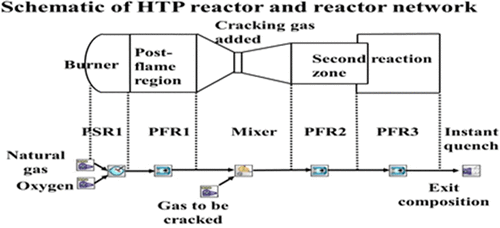当前位置:
X-MOL 学术
›
Ind. Eng. Chem. Res.
›
论文详情
Our official English website, www.x-mol.net, welcomes your
feedback! (Note: you will need to create a separate account there.)
Modeling Study of High Temperature Pyrolysis of Natural Gas
Industrial & Engineering Chemistry Research ( IF 3.8 ) Pub Date : 2018-05-23 , DOI: 10.1021/acs.iecr.8b00758 Soumya Gudiyella 1 , Zachary J. Buras 1 , Te-Chun Chu 1 , Istvan Lengyel 2 , Sreekanth Pannala 2 , William H. Green 1
Industrial & Engineering Chemistry Research ( IF 3.8 ) Pub Date : 2018-05-23 , DOI: 10.1021/acs.iecr.8b00758 Soumya Gudiyella 1 , Zachary J. Buras 1 , Te-Chun Chu 1 , Istvan Lengyel 2 , Sreekanth Pannala 2 , William H. Green 1
Affiliation

|
High temperature pyrolysis (HTP) is a commercial process to convert methane to acetylene. The HTP process consists of two reaction zones, followed by a quenching zone. In this work, a pilot scale HTP process was modeled to assess the effect of the amount of fuel burned and the cracking gas composition on acetylene and polycyclic aromatic hydrocarbon (PAH) production. The HTP process is simulated using a chemical reactor network, which consists of a series of ideal reactors. The composition of cracking gas in the second reaction zone varied from methane to hexane. The propensity of the feed to form acetylene vs PAH at a given process condition was determined using a detailed chemical kinetic mechanism. The chemical kinetic mechanism was developed using an automated mechanism generation software package, the Reaction Mechanism Generator (RMG). Compared to existing pyrolysis mechanisms that can only be used to model the cracking of a finite number of species, RMG can be used to model the cracking of any arbitrary species consisting of carbon, hydrogen, and oxygen. The modeling results showed that the C2 yield is largely independent of either overall φ or cracking gas carbon number. In contrast, the lumped aromatic yield appears to have a positive correlation with both overall φ and cracking gas carbon number. Sensitivity and rate of production analyses were performed to identify the important pathways that lead to the formation of aromatics for various feed compositions.
中文翻译:

天然气高温热解的模型研究
高温热解(HTP)是将甲烷转化为乙炔的商业方法。HTP工艺包括两个反应区,然后是淬火区。在这项工作中,对中试规模的HTP工艺进行了建模,以评估燃料燃烧量和裂解气成分对乙炔和多环芳烃(PAH)生产的影响。使用化学反应器网络模拟HTP过程,该化学反应器网络由一系列理想的反应器组成。第二反应区中裂化气体的组成从甲烷到己烷变化。使用详细的化学动力学机制确定了在给定的工艺条件下进料形成乙炔对PAH的倾向。化学动力学机制是使用自动机制生成软件包“反应机制生成器”(RMG)开发的。与只能用于模拟有限种类的裂解的现有热解机理相比,RMG可用于模拟由碳,氢和氧组成的任意种类的裂解。建模结果表明,C2收率很大程度上与总φ或裂化气碳数无关。相反,集总的芳烃产率似乎与总φ和裂化气碳数均呈正相关。进行了敏感性和生产率分析,以确定导致各种饲料组合物形成芳烃的重要途径。
更新日期:2018-05-24
中文翻译:

天然气高温热解的模型研究
高温热解(HTP)是将甲烷转化为乙炔的商业方法。HTP工艺包括两个反应区,然后是淬火区。在这项工作中,对中试规模的HTP工艺进行了建模,以评估燃料燃烧量和裂解气成分对乙炔和多环芳烃(PAH)生产的影响。使用化学反应器网络模拟HTP过程,该化学反应器网络由一系列理想的反应器组成。第二反应区中裂化气体的组成从甲烷到己烷变化。使用详细的化学动力学机制确定了在给定的工艺条件下进料形成乙炔对PAH的倾向。化学动力学机制是使用自动机制生成软件包“反应机制生成器”(RMG)开发的。与只能用于模拟有限种类的裂解的现有热解机理相比,RMG可用于模拟由碳,氢和氧组成的任意种类的裂解。建模结果表明,C2收率很大程度上与总φ或裂化气碳数无关。相反,集总的芳烃产率似乎与总φ和裂化气碳数均呈正相关。进行了敏感性和生产率分析,以确定导致各种饲料组合物形成芳烃的重要途径。











































 京公网安备 11010802027423号
京公网安备 11010802027423号